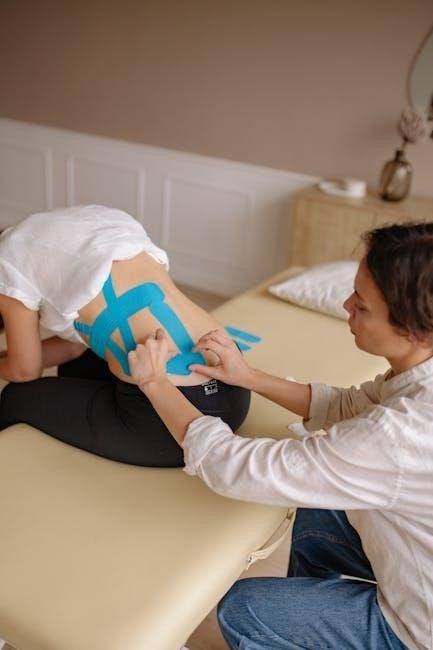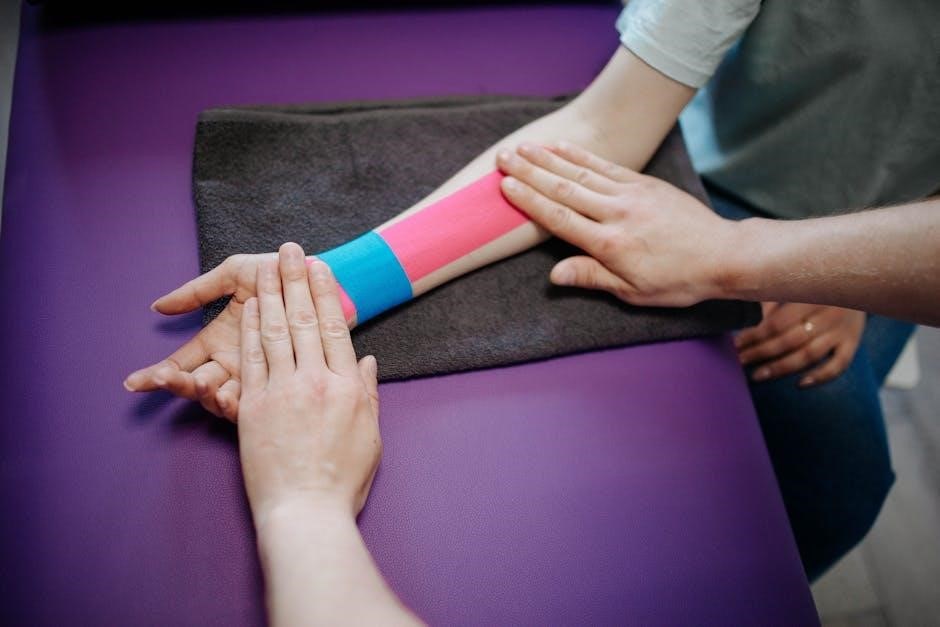Hamstring injuries are common in sports, involving the biceps femoris, semitendinosus, and semimembranosus muscles. They often result from sprinting, jumping, or sudden stops. Rehabilitation focuses on restoring strength, flexibility, and function to enable a safe return to activity.
1.1. Understanding Hamstring Anatomy
The hamstrings are a group of three muscles in the posterior thigh: the biceps femoris, semitendinosus, and semimembranosus. These muscles originate from the ischial tuberosity and insert into the tibia and fibula. They play a crucial role in hip extension and knee flexion, essential for activities like running and jumping. The hamstrings also include the sciatic nerve, which can be sensitive to injury. Understanding their anatomy is vital for designing effective rehabilitation programs, as injuries often occur at the muscle-tendon junction or within the muscle belly itself. Accurate anatomical knowledge aids in targeting specific areas during recovery.
1.2. Common Causes of Hamstring Injuries
Hamstring injuries often occur during activities involving sprinting, jumping, or sudden stops, leading to muscle strains or tears. Overstretching, poor flexibility, and weak or imbalanced muscles contribute to the risk. Athletes in sports like soccer, football, and track are particularly vulnerable. Muscle fatigue, improper warm-ups, and previous injuries also increase susceptibility. Additionally, biomechanical issues, such as poor running mechanics, can strain the hamstrings. Understanding these causes is essential for developing effective prevention and rehabilitation strategies to reduce the likelihood of injury and promote faster recovery.
1.3. Importance of Rehabilitation Exercises
Rehabilitation exercises are crucial for restoring strength, flexibility, and function after a hamstring injury. They prevent muscle atrophy, improve joint stability, and reduce the risk of re-injury. A well-structured program includes stretching, strengthening, and functional activities tailored to the individual’s needs. Consistent exercise promotes faster recovery, allowing athletes to return to their sport safely. Proper rehabilitation also enhances overall muscle balance and movement efficiency, which are key for long-term performance and injury prevention. Adherence to a rehabilitation plan is essential for achieving optimal outcomes and minimizing downtime.
Overview of Non-Operative Rehabilitation
Non-operative rehabilitation focuses on restoring function and strength without surgery. It involves a phased approach, including acute management, exercises, and gradual progression, tailored to the injury severity.
2.1. Acute Management of Hamstring Injuries
Acute management focuses on reducing pain and inflammation. Ice therapy, compression, and activity modification are essential. Gentle exercises are introduced to maintain mobility without overloading the injured muscles, promoting healing.
2.2. Role of Ice and Compression in Recovery
Ice therapy reduces inflammation and pain by constricting blood vessels, while compression limits swelling. Both are applied in the acute phase, typically within 72 hours of injury. Ice is used for 15-20 minutes multiple times a day, and compression sleeves or bandages are worn to minimize edema, accelerating the recovery process and preventing further tissue damage.
2.3. Early Mobilization Techniques
Early mobilization is crucial for preventing stiffness and promoting recovery after a hamstring injury. Gentle exercises, such as heel slides and straight leg raises, are often recommended to maintain range of motion without causing further strain. These techniques should be performed in a pain-free manner to avoid aggravating the injury. Gradual progression of movement helps restore function and strength, reducing the risk of long-term limitations. Mobilization should be tailored to the individual’s recovery stage, ensuring a balance between activity and rest to support optimal healing and prevent re-injury.
Stretching Exercises for Hamstring Recovery
Stretching is essential for restoring hamstring flexibility and preventing future injuries. Techniques include standing stretches, supine 90/90 stretches, and lunging hip flexor stretches to improve range of motion.
3.1. Standing Hamstring Stretch
The standing hamstring stretch is a fundamental exercise for improving flexibility. Stand with feet shoulder-width apart, then bend forward at the hips, reaching toward the toes. Keep knees slightly bent and hold for 30 seconds. Perform 2-3 sets daily. This stretch targets the biceps femoris, semitendinosus, and semimembranosus muscles, aiding in recovery and reducing tightness. Proper form is crucial to avoid strain. Regular practice enhances mobility and helps prevent reinjury, making it a key component of hamstring rehabilitation programs.
3.2. Supine 90/90 Hamstring Stretch
The supine 90/90 hamstring stretch is performed while lying on the back with both hips and knees bent at 90 degrees. One leg is placed against a wall or door frame, and the other leg rests on the floor. Gently lean toward the wall until a stretch is felt in the hamstring. Hold for 20-30 seconds and repeat 2-3 times on each leg. This stretch is effective for improving hamstring flexibility without putting excessive strain on the lower back. It is often recommended in the early stages of rehabilitation to promote gentle lengthening of the hamstring muscles.
3.3. Lunging Hip Flexor Stretch
The lunging hip flexor stretch targets the hip flexors, which are closely linked to hamstring function. Start by kneeling on one leg with the other foot in front, forming a 90-degree angle. Keep the back straight and gently push the hips forward until a stretch is felt in the front of the hip. Hold for 20-30 seconds and switch legs. This stretch improves hip flexibility, reduces muscle tension, and enhances overall lower extremity mobility, making it an essential component of hamstring rehabilitation programs to prevent imbalances and promote proper movement patterns.

Strengthening Exercises
Strengthening exercises are crucial for restoring hamstring function and preventing re-injury. They focus on improving muscle endurance, power, and coordination through targeted movements and progressive resistance.
4.1. Isometric Hamstring Curls
Isometric hamstring curls are a foundational exercise in rehabilitation, focusing on muscle activation without joint movement. They help strengthen the hamstrings while minimizing strain on injured tissues. To perform, lie on your back with knees bent at 90 degrees. Engage your core and press your heels into the floor, contracting the hamstrings without moving your hips. Hold for 5-10 seconds, then release slowly. Start with 3 sets of 10 repetitions, gradually increasing duration and resistance as strength improves. This exercise is ideal for early stages of recovery, promoting muscle stability and control.
4.2. Eccentric Strengthening Exercises
Eccentric strengthening exercises focus on the lengthening phase of muscle contraction, crucial for rebuilding hamstring strength and resilience. These exercises mimic real-world movements and reduce re-injury risk. A popular example is the Nordic hamstring curl, where you start on your knees with resistance, then slowly lower your torso. Perform 3 sets of 8-12 repetitions, progressing gradually. Eccentric training enhances muscle-tendon interaction, improving durability and function, making it a cornerstone of advanced rehabilitation programs.
4.3. Progressive Resistance Band Training
Progressive resistance band training is an effective method for strengthening hamstrings post-injury. Using resistance bands, exercises like banded hamstring curls and hip thrusts can be performed. Start with lighter bands and gradually increase resistance as strength improves. This approach enhances muscle activation and promotes functional recovery. Ensure proper form to avoid strain, and perform 3 sets of 12-15 repetitions. This versatile training modality is ideal for both home and clinical settings, supporting a tailored rehabilitation program focused on restoring hamstring function and reducing re-injury risk.

Functional Exercises for Hamstring Rehabilitation
Functional exercises mimic real-life movements to restore hamstring function and prepare for return to activity. They include step-ups, balance drills, and sport-specific agility tasks to enhance coordination and strength.
5.1. Step-Ups and Balance Training
Step-ups and balance training are essential for restoring functional strength and stability post-hamstring injury. Step-ups target the hamstrings, glutes, and quads, improving coordination and power. Start with low steps, focusing on proper form: keep your back straight, engage your core, and avoid letting your knee extend past your toes. Progress to higher steps as strength increases; Balance exercises, such as single-leg stands or wobble board work, enhance proprioception and stability. These exercises mimic real-life movements, reducing the risk of re-injury and preparing the athlete for dynamic sports-specific actions. Consistency and gradual progression are key to achieving optimal results.
5.2. Agility Drills for Sport-Specific Movement
Agility drills are crucial for restoring sport-specific movement patterns after a hamstring injury. These exercises mimic the dynamic actions of sports, such as cutting, pivoting, and accelerating. Examples include zigzag running, shuttle runs, and cone drills. Start with low-intensity, controlled movements to avoid overloading the hamstrings. Progress to higher speeds and more complex patterns as strength and confidence improve. Agility drills not only enhance speed and coordination but also improve reaction time and muscle memory. They are essential for bridging the gap between basic rehabilitation and return to competitive sports, ensuring athletes can perform at pre-injury levels safely and effectively.
5.3. Plyometric Exercises for Power Restoration
Plyometric exercises, such as box jumps and depth jumps, are introduced in the final stages of hamstring rehabilitation to restore explosive power. These drills focus on rapid, high-intensity movements that mimic the demands of sports. Start with low-height jumps to minimize stress on the hamstrings. Progressively increase the intensity and complexity as strength and control improve. Proper technique is critical to prevent re-injury. Plyometrics enhance power output, enabling athletes to return to activities requiring sudden accelerations and decelerations. They are a key component of late-stage rehabilitation, bridging the gap between strength training and full athletic performance.

Pain Management and Exercise Progression
Managing discomfort with ice and compression aids recovery. Exercises are progressed gradually, ensuring pain remains mild. Monitoring for overexertion signs ensures a balanced approach to rehabilitation.
6.1. Pain-Free Exercise Guidelines
Exercises should be performed with minimal discomfort, ensuring activities remain pain-free or near pain-free. If an exercise causes pain exceeding a 2 on the VAS scale, it should be discontinued.
This approach prevents overexertion and promotes healing. Modalities like ice and compression can aid in managing post-exercise soreness.
Progression is tailored to individual tolerance, focusing on gradual increases in intensity and duration.
Pain-free guidelines ensure a safe and effective rehabilitation process, reducing the risk of re-injury.
6.2. Gradual Increase in Exercise Intensity
Exercise intensity should be progressively increased to avoid plateaus and promote continuous improvement. This gradual approach ensures the hamstring muscles adapt without risking re-injury.
Initially, low-load exercises like isometric curls and supine stretches are used. As strength and flexibility improve, resistance and dynamic movements are introduced;
Each progression is guided by clinical assessment and patient feedback, ensuring exercises remain challenging yet safe; This phased intensity increase helps restore functional strength and prepares the hamstrings for sports-specific demands;
6.3. Monitoring for Signs of Overexertion
Monitoring for signs of overexertion is crucial during hamstring rehabilitation to prevent re-injury. Key indicators include increased pain, swelling, or reduced functional ability.
Patients should report any sharp or persistent pain, as this may signal overexertion. Clinicians assess progress through strength tests, range of motion, and functional movements.
Exercise intensity is adjusted based on these observations, ensuring a balance between progression and safety. Pain scales, such as the Visual Analog Scale (VAS), can help quantify symptoms and guide adjustments to the rehabilitation program.

Return-to-Sport Criteria
Return-to-sport criteria include achieving pre-injury strength, full range of motion, and functional movement patterns. Psychological readiness and pain-free performance in sport-specific tasks are also essential.
7.1. Strength and Flexibility Benchmarks
Strength and flexibility benchmarks are critical for determining readiness to return to sport after a hamstring injury. Athletes must demonstrate near-normal muscle balance between the hamstrings and quadriceps, with strength measured through isometric or eccentric tests. Flexibility is assessed via range-of-motion exercises, ensuring minimal asymmetry between legs. Functional assessments, such as single-leg deadlifts or Nordic hamstring exercises, are used to evaluate dynamic control. Achieving these benchmarks reduces the risk of reinjury and ensures optimal performance. Symmetry in strength and flexibility is a key indicator of successful rehabilitation and readiness for sport-specific activities.
7.2. Functional Movement Assessments
Functional movement assessments evaluate an athlete’s ability to perform sport-specific movements safely and effectively. These assessments include tests like single-leg stands, step-ups, and agility drills to identify compensatory patterns or limitations. They ensure that the hamstring muscles can withstand dynamic forces and maintain proper movement mechanics. Clinicians use these assessments to confirm that the injured leg functions symmetrically with the uninjured leg, reducing the risk of reinjury. Successful completion of functional tests is a critical milestone before advancing to full sports participation, ensuring the athlete’s readiness for competitive demands.
7.3. Psychological Readiness for Return
Psychological readiness is crucial for an athlete’s successful return to sport after a hamstring injury. Fear of reinjury, anxiety, and decreased confidence often persist, even after physical recovery. Addressing these mental barriers through counseling, positive reinforcement, and gradual exposure to sport-specific scenarios is essential. Athletes must regain trust in their hamstrings’ strength and functionality. Setting realistic goals and celebrating progress fosters a mindset prepared for competition. Psychological readiness ensures the athlete is mentally resilient and motivated, reducing the likelihood of hesitation or poor decision-making during play.
Exercise Progression and Monitoring
Exercise progression involves gradual intensity increases, monitoring for pain, and adjusting routines based on individual recovery. This ensures safe advancement through rehabilitation phases without risking re-injury.
8.1. Phase 1: Acute Phase Exercises
Phase 1 focuses on managing pain, reducing inflammation, and maintaining range of motion. Gentle exercises include isometric contractions, supine 90/90 stretches, and seated hamstring stretches. Ice and compression are used to minimize swelling. Activities are limited to pain-free movements to avoid exacerbating the injury. Early mobilization techniques, such as controlled leg raises and soft tissue mobilization, are introduced to prevent stiffness. Patient education emphasizes avoiding aggressive stretching or heavy loading during this critical healing period. Monitoring for improvements in pain and mobility guides progression to the next phase.
8.2. Phase 2: Subacute Strengthening
Phase 2 focuses on progressive strengthening and restoring muscle endurance. Gentle resistance exercises, such as heel slides and isometric hamstring curls, are introduced. Resistance bands or light weights may be incorporated to enhance strength. Pain-free stretching continues, emphasizing improved flexibility. Functional movements, like step-ups and balance exercises, are gradually added to prepare for more dynamic activities. This phase typically lasts 2-4 weeks, with the goal of rebuilding strength and endurance while minimizing the risk of re-injury. Close monitoring ensures exercises remain pain-free and progression aligns with individual recovery.
8.3. Phase 3: Dynamic and Sports-Specific Training
Phase 3 focuses on dynamic and sports-specific exercises to restore power, speed, and agility. Activities like high knees, carioca drills, and box jumps are introduced to mimic game-like movements. Plyometric exercises, such as jump squats and lunges, are incorporated to enhance explosive strength. Sport-specific drills, like sprinting and cutting maneuvers, are tailored to the athlete’s requirements. This phase emphasizes functional movements, ensuring the hamstring muscles can withstand the demands of the sport. The duration varies based on recovery progress but typically lasts until the athlete is cleared for full activity, ensuring a seamless return to competition.

Injury Prevention Strategies
Incorporating eccentric exercises, neuromuscular control drills, and regular stretching helps prevent hamstring injuries. Consistency in these practices reduces injury risk and enhances overall muscle resilience.
9.1. Eccentric Training for Injury Prevention
Eccentric training focuses on lengthening muscle contractions, enhancing hamstring strength and resilience. Key exercises include the Nordic hamstring curl and sliding hamstring curls. These workouts target the biceps femoris, semitendinosus, and semimembranosus, improving muscle stiffness and reducing injury risk. Proper form and gradual progression are crucial to avoid overexertion. Studies show that consistent eccentric training lowers hamstring strain rates in athletes, particularly in sports involving sprinting and rapid accelerations. Incorporating these exercises into a routine can significantly bolster injury prevention efforts and enhance overall muscle function.
9.2. Neuromuscular Control Exercises
Neuromuscular control exercises improve proprioception, balance, and muscle coordination, reducing hamstring injury risk. Activities like single-leg stance, step-ups, and balance drills enhance stability. Strengthening the glutes and core muscles ensures proper movement patterns, minimizing strain on the hamstrings. These exercises address muscle imbalances and poor activation, common in athletes with prior injuries. Incorporating plyometric and agility drills further refines neuromuscular control, aiding in sport-specific movements. Consistent practice helps prevent re-injury by optimizing muscle recruitment and joint stability, fostering a safer return to athletic activities.
9.3; Regular Stretching and Foam Rolling
Regular stretching and foam rolling are essential for maintaining hamstring flexibility and reducing muscle tension. Standing hamstring stretches and supine 90/90 stretches target tight muscles, improving range of motion. Foam rolling the hamstrings, glutes, and calves helps reduce muscle soreness and promotes blood flow. Consistent stretching prevents muscle imbalances and lowers injury risk. Incorporating these practices into daily routines enhances overall muscle health and supports long-term injury prevention. Proper technique and regularity are key to maximizing benefits and maintaining optimal muscle function for athletic performance.
Effective hamstring injury rehabilitation requires a combination of stretching, strengthening, and progressive exercises. Consistency and adherence to protocols are crucial for successful recovery and preventing future injuries.
10.1. Summary of Key Rehabilitation Principles
Effective hamstring rehabilitation combines stretching, strengthening, and functional exercises. Early mobilization, ice, and compression reduce inflammation. Gradual progression ensures strength and flexibility without re-injury. Pain-free exercises prioritize tissue repair. Eccentric training enhances resilience, while sports-specific drills restore function. Consistency and adherence to protocols are vital for optimal recovery and long-term injury prevention.
10.2. Long-Term Benefits of Consistent Exercise
Consistent exercise post-hamstring injury enhances muscle strength, improves flexibility, and restores neuromuscular control. Regular stretching and strengthening reduce recurrence risk and boost athletic performance. Over time, these practices promote tendon resilience, minimizing future injury potential. Long-term adherence fosters overall lower limb stability and endurance, benefiting both daily activities and sports participation. Sustained effort ensures lasting recovery and optimal physical function.
10.3. Final Tips for Successful Recovery
For optimal recovery, prioritize pain-free exercises, gradually increasing intensity. Monitor for signs of overexertion and adjust routines accordingly. Maintain consistent practice to build strength and flexibility. Incorporate sport-specific drills to prepare for return. Stay patient, as recovery is a gradual process. Adhere to a structured rehabilitation plan and communicate openly with healthcare providers. Regular stretching and foam rolling can prevent future injuries. By following these guidelines, athletes can achieve full recovery, reduce recurrence risk, and regain peak performance levels effectively.
